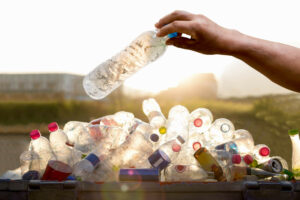A flurry of stories have recently hit the headlines about plastics and recycling, from demands for a tax on plastic drinking straws to the naming and shaming some of the worst offenders for unrecyclable packaging.
This in turn has promoted renewed calls for manufacturers to produce packaging that can be used again and again, and to factor recycling and reuse into product designs. As well as product design, human behaviour has a lot to do with recycling rates. In 2015, recycling rates in the UK fell for the first time – dropping from 44.8% in 2014 to 43.9% in 2015 (the most recent years for which data is currently available).
Behavioural and practical changes
In order for the circular economy goal to be realised, both practical and behavioural changes need to take place in the way we view and use plastics.
Contrary to popular belief, plastics have a very resource-efficient profile – particularly those produced from recycled materials. Even plastics produced from virgin materials use just 4% of the oil produced worldwide, with much less energy used in production compared to other materials given the vast breadth of usage in every aspect of modern life.
It may not be very fashionable to bandy about statistics like this, but when we’re talking about a subject as critical as the future health of our planet and all its inhabitants, it’s important to get the facts straight.
Plastics can be easily recycled

Crucially, responsibly produced plastics can be recycled effectively and efficiently, or used to generate energy from waste (EFW) at the end of their useful life. Responsibly produced plastic packaging also brings value and efficiencies to the supply chain – weighing less than alternatives like glass and metal, it also extends shelf life, minimising food waste.
Where recycling is not practical, the EFW process can recover the small amount of oil used to create plastic packaging at the end of its useful life, diverting it from landfill and helping power our towns and cities.
The challenges come when products are overpackaged, or feature complicated multi-material packaging and pigments that cannot easily be recycled, if at all, and end up in landfill, or even worse as litter in the wider environment.
So how are we helping to contribute to a more sustainable economy? From a practical view point, we are proud that most of our waste and recycling sacks are made from 97-100% recycled polyethylene.
At the same time, when our waste and recycling sacks are used as part of recycling schemes, they help with the collection and recovery of other recyclables, which in turn are fed back into the production cycle.
Improving segregation at disposal
We also think long and hard about segregation at the point of disposal, and are constantly striving to improve segregation rates across sectors – from hazardous waste in healthcare to household recycling – to achieve a better outcome for all.
Behavioural changes are also being shaped thanks to our close work with local councils around the UK to come up with ways of making recycling as accessible as possible for residents, including those living in flats.
We encourage the return of post-industrial and post-consumer plastics, board and other materials to the production cycle for re-processing, and carefully manage any waste arising from site operations, championing recovery and reuse wherever possible.
And in addition to encouraging our suppliers and customers to adopt environmental best practice, we regard government legislation and our own company policies as minimum standards, which should be improved upon wherever it is reasonable to do so.
Sustainable from the ground up
Sustainability is part of our DNA – we would not be economically viable as a company if we did not shape our business around sustainable principles and the use of recycled materials.
We are striving to help our economy move away from the traditional linear model of using then disposing of plastics and other resources, to a more efficient system that retains the value of resources and keeps them circulating in the economy for longer. So, the next time you hear someone berating the use of plastic packaging, remember that it’s what you do with the packaging after use that matters most, not the fact that it exists.